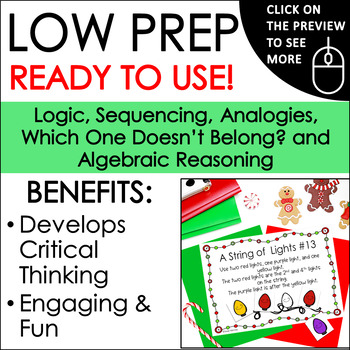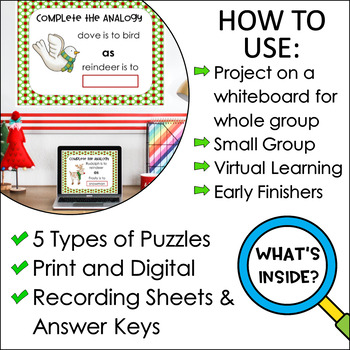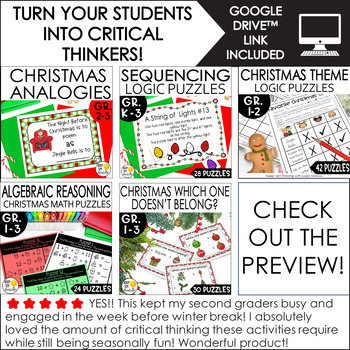Christmas Critical Thinking Bundle | Logic | Sequencing | Math Puzzles
- Zip

What educators are saying
Products in this Bundle (5)
Description
This is a bundle of my five CHRISTMAS CRITICAL THINKING PRODUCTS for grades 1-3. This bundle teaches logic and deductive reasoning, analogies and classifying, and attribute listing to get your kiddos thinking at those higher levels. This bundle is completely updated with new clip art and fonts and now includes a digital version of each product from use in Google Slides™.
Purchase this bundle and save 20% off the price if purchased separately!
HOW CAN I USE THIS PRODUCT?
- In a Center: Print out the puzzle cards on card stock and laminate or put them in a dry erase pocket.
- As a Morning Warm-up Activity: Project the puzzles on a SmartBoard, use an LCD projector, or use an ELMO. Print out the puzzles on paper and use it as a worksheet. Have students work individually or in pairs.
- Think, Pair, Share: Print out the puzzle cards on plain paper or card stock. Give each group of students a puzzle to solve.
- For Early Finishers: Have a folder of the puzzles in an early finisher center.
PLEASE NOTE: The digital versions of the files are store on Google™ Drive and formatted as Google™ Slides. You will need a Google™ Classroom or Google™ Drive account to access these files. There is a PDF file included in the download with links to the three files. You will click on each link. A page will appear that allows you to make a copy of the file to your Google™ account.
*****************************************************************************************************
BELOW ARE LINKS TO MY OTHER PRODUCTS YOU MIGHT BE INTERESTED IN:
Math Logic Task Cards – Addition and Subtraction
Spring Matrix Logic Puzzles for Grades 1-3
St. Patrick’s Day Beginning Logic Puzzles for Grades 1-3
Beginning Logic Puzzles for Back to School and Fall Gr. 1-3
Beginning Logic Puzzles for Winter Grades 1-3
*****************************************************************************************************
CUSTOMER TIPS:
Follow me to be notified when I post a new product. All my products are 50% off for the first 48 hours, so it pays to be a follower!
TERMS:
Copyright © Keep ‘em Thinking!, Susan Morrow. This product is for classroom and personal use ONLY. It may be used only by the original downloader Copying for more than one teacher, classroom, department, school, or school system is prohibited. You may not distribute or display this product digitally for public view. Failure to comply is a copyright infringement and a violation of the Digital Millennium Copyright Act (DMCA).
*****************************************************************************************************
Remember to always … Keep 'em Thinking!
Susan Morrow
CONNECT WITH ME!





